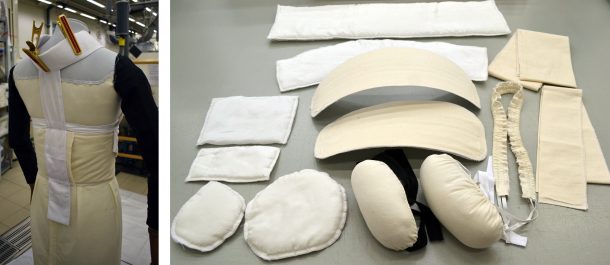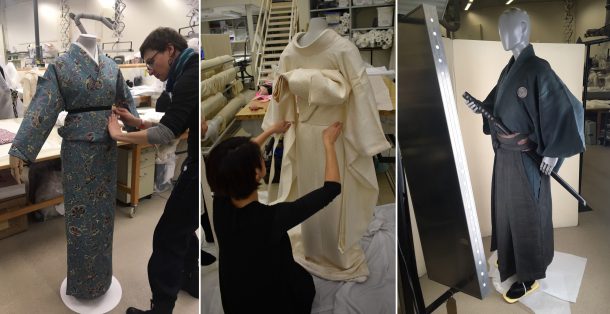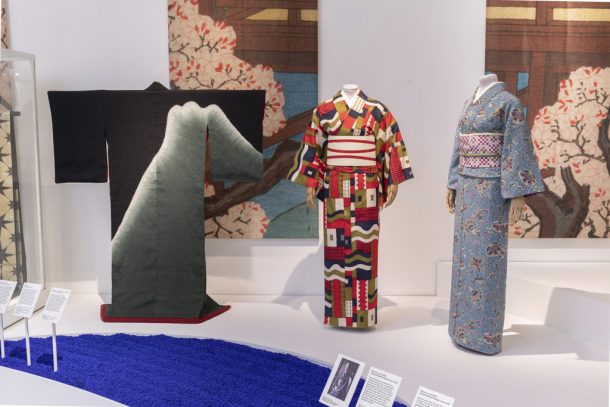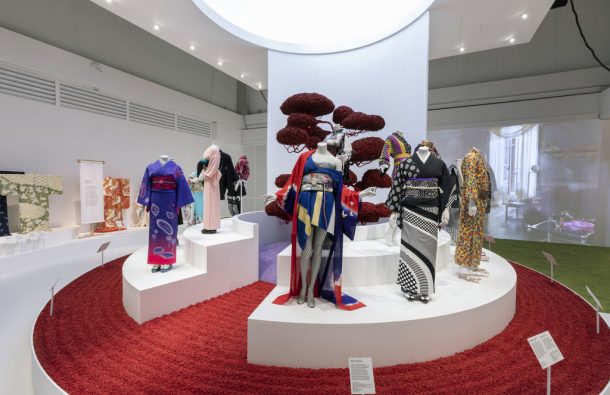by Rachael Lee and Gesa Werner, Senior Textile Conservation Display Specialists
At the Victoria and Albert Museum, kimono have traditionally been exhibited as two-dimensional works of art, mounted onto T-bar stands. Not only is this a safe method of display for fragile surfaces, but it also highlights the design, artistry and craftsmanship of these garments. Whilst T-bars remain an established form of display, this flat mounting method ignores the original function of kimono as a three-dimensional piece of clothing – the word ‘kimono’ literally translates as ‘a thing to wear’.
This phrase came to provide an important curatorial goal for the 2019 exhibition Kimono: Kyoto to Catwalk, which featured over 100 kimono from seventeenth century Kyoto to modern day Tokyo. The exhibition aimed to present kimono as dynamic and fashionable dress with contemporary relevance, challenging the traditional view of this iconic garment. This meant that for the first time, kimono were mounted onto a range of different mannequins, fully accessorized with collars, tabi (socks) and geta (sandals), alongside artfully draped T-bars.
A kimono is a long straight-cut garment with wide-sleeves set at right angles. It has no integral fastenings and in modern day use, body padding, under-sashes and ribbons hold the kimono in place and give definition. The obi, a decorative fabric belt up to four meters in length, is then secured tightly around the waist and tied into an elaborate knot, known as musubi. The dressing process is complex with subtle changes in etiquette for different periods and types of kimono. As non-Japanese practitioners with limited experience in wearing or styling kimono, it was vital to consult and work with Japanese specialists in order to achieve authenticity and aesthetic balance between the multiple components. Textile Conservation worked closely with London-based stylist Ms. Mamiko Sato and Tokyo-based curatorial adviser, Ms. Kohka Yoshimura. Under their expert guidance the mounting process was broken down into stages that could be carried out by the V&A Costume Mounting Team.
Firstly, appropriately sized mannequins were sourced for the different periods of dress. For historical men’s and women’s kimono, petite dress-stands were selected. The height of the dress-stand as well as the length of the arms could be easily adjusted, meaning crucial details like the positioning of the cuff on the wrist could be achieved. For contemporary womenswear there was a greater choice of stylized fiberglass mannequins, that demonstrated kimono can be worn by anyone, as either costume, performance or through personal styling. A new male mannequin was developed for contemporary menswear. The slimmed-down figure was made slightly shorter ensuring the length of the kimono would sit accurately around the ankles. This highlighted the feet which were moulded flat with separated toes, enabling setta and geta (footwear) to be safely mounted as part of an ensemble.
Once all of the mannequins were selected each figure was padded with layers of polyester wadding. By filling in the waist and flattening the chest, the curves of the hips and bust were minimized. This created a more uniform silhouette, which in turn helped to maximize the fabric surface area of the kimono and emphasise the elegance of straight lines.
The second stage was making underpinnings from conservation-approved materials. Traditionally a juban (undergarment) is worn against the body to protect the kimono from perspiration and wear, with the only visible part being its collar. As many of the kimono no longer had this original under-layer, replicas were substituted. The positioning of the juban collar dictated the form of the kimono, in particular the deep curve at the back of the neck, which is an important design feature for many kimono (Figure 1). Extra items that would typically be used in kimono dressing were made in-house, including obi pillows, waist-stiffeners, and cotton sashes. With all the necessary items to hand the third stage, the actual process of dressing, could begin.

Following the golden rule of folding the proper left side over the right, each kimono was wrapped closely around the mannequin’s hips. The seams were aligned and kept as straight as possible in order to maintain an even surface. Simultaneously the final length of the kimono was established by folding the excess fabric into a deep horizontal tuck around the lower waist. Padded elastic ties, sashes and soft pads helped to support the material and keep layers firmly in place (Figure 2).

Once satisfied with the positioning of the kimono the obi could then be dressed. Obi tying can be an intricate process as they vary greatly in size and material, from heavy brocades to lightweight silks. Therefore, the tying of each obi required practice with a replica toile to avoid over handling. The position and length of the obi had to be carefully considered in order to leave enough fabric to create the musubi (knot), tied at the center-back waist. There are numerous knot variations dependent on the style of each obi or kimono and over ten different knots were fashioned for the exhibition. Two important accessories complete the obi aesthetic including the obiage (a scarf-like length of fabric) and obijime (a braided cord). Both serve as decorative and supportive items with the obiage hiding support pads and the obijime holding the obi knot in place.

The beauty of kimono is fully appreciated when worn. By utilizing three-dimensional display methods, including dynamically posed mannequins, wigs and props, kimono were brought to life and transformed into a contemporary exhibition setting, complemented by traditional T-bar displays (Figures 3 and 4).

The dressing of kimono is an art which not only requires an array of practical skills and techniques but also a sharp eye to create the shapes, proportions, and balance for each individual kimono. By working with Japanese specialists, we were able to develop bespoke underpinnings to support traditional dressing methods. This collaborative approach enabled us to successfully mount kimono as wearable and authentic items of dress, while at the same time maintaining conservation standards and developing new skills.
Acknowledgements
We are grateful to Anna Jackson, Keeper, Asian Department, and Josephine Rout, Curator, Asian Department, for their continued support throughout this project. We would particularly like to thank Ms. Kohka Yoshimura and Ms. Mamiko Sato for their generous guidance and advice.


